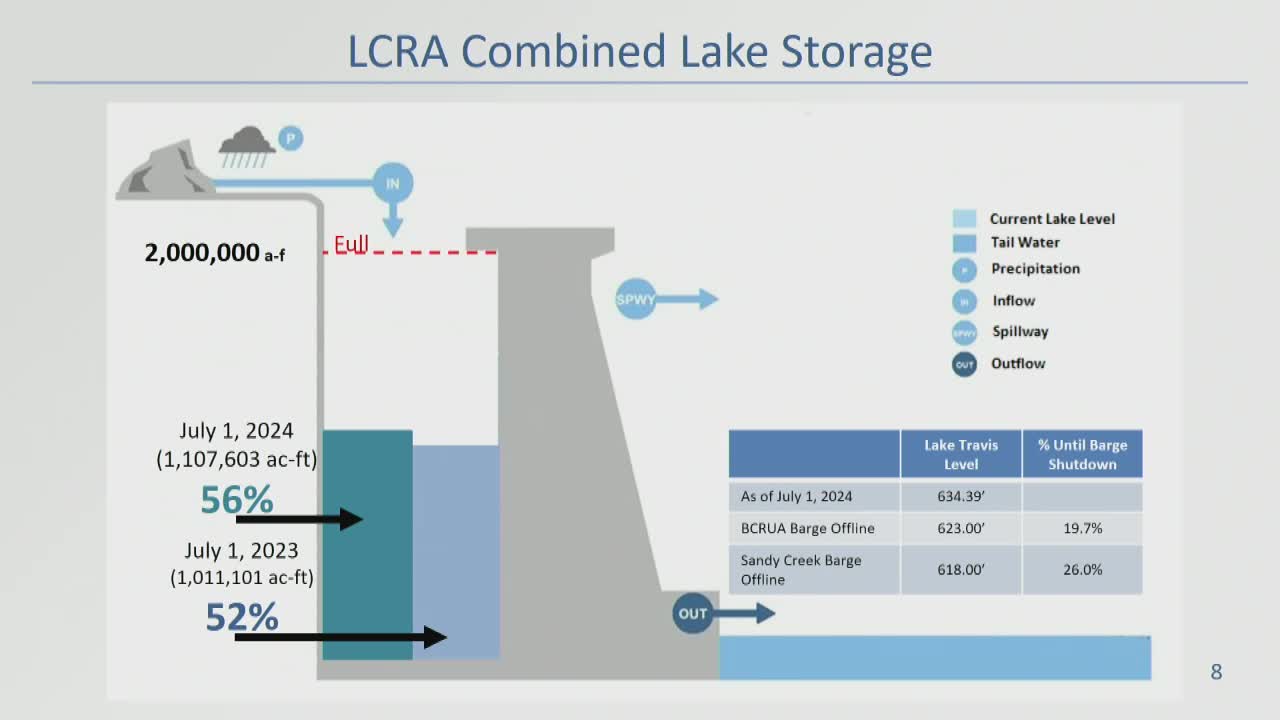Drought conditions improve as Central Texas lakes stabilize
July 18, 2024 | Leander, Williamson County, Texas

This article was created by AI summarizing key points discussed. AI makes mistakes, so for full details and context, please refer to the video of the full meeting. Please report any errors so we can fix them. Report an error »

In a recent government meeting, officials discussed the current water levels and drought conditions affecting local lakes, particularly Lake Buchanan and Lake Travis. As of now, Lake Buchanan is approximately 73% full, while Lake Travis remains significantly lower at 42%. The stabilization of lake levels has been attributed to water management practices, including the transfer of water from Buchanan to Travis.
The meeting highlighted improvements in soil moisture conditions compared to last year, although officials cautioned that the region is not yet out of drought. The majority of the basin feeding Lake Buchanan has shown positive signs, while the southern part, which feeds Lake Travis, continues to struggle with lower inflows. Notably, May marked a significant increase in inflows, surpassing averages for the first time in years, with hopes for continued improvement into July.
Long-range projections indicate that if current wet conditions persist, the region may avoid activating drought response measures this year. However, should dry conditions return, officials are preparing to implement a drought barge operation by next summer. The meeting also addressed water usage trends, noting a recent peak in demand that has since stabilized, allowing for better management of water resources.
In a separate discussion, the Historic Preservation Commission member shared insights on the area's historical drought and flood cycles, emphasizing the significance of the 1957 flood, which marked the end of a severe drought and led to the establishment of flood control measures in Texas. This historical context serves as a reminder of the region's vulnerability to extreme weather patterns and the importance of ongoing water management efforts.
Overall, the meeting conveyed a cautiously optimistic outlook on water levels and usage, while also acknowledging the need for preparedness in the face of potential drought conditions.
The meeting highlighted improvements in soil moisture conditions compared to last year, although officials cautioned that the region is not yet out of drought. The majority of the basin feeding Lake Buchanan has shown positive signs, while the southern part, which feeds Lake Travis, continues to struggle with lower inflows. Notably, May marked a significant increase in inflows, surpassing averages for the first time in years, with hopes for continued improvement into July.
Long-range projections indicate that if current wet conditions persist, the region may avoid activating drought response measures this year. However, should dry conditions return, officials are preparing to implement a drought barge operation by next summer. The meeting also addressed water usage trends, noting a recent peak in demand that has since stabilized, allowing for better management of water resources.
In a separate discussion, the Historic Preservation Commission member shared insights on the area's historical drought and flood cycles, emphasizing the significance of the 1957 flood, which marked the end of a severe drought and led to the establishment of flood control measures in Texas. This historical context serves as a reminder of the region's vulnerability to extreme weather patterns and the importance of ongoing water management efforts.
Overall, the meeting conveyed a cautiously optimistic outlook on water levels and usage, while also acknowledging the need for preparedness in the face of potential drought conditions.
View full meeting
This article is based on a recent meeting—watch the full video and explore the complete transcript for deeper insights into the discussion.
View full meeting
